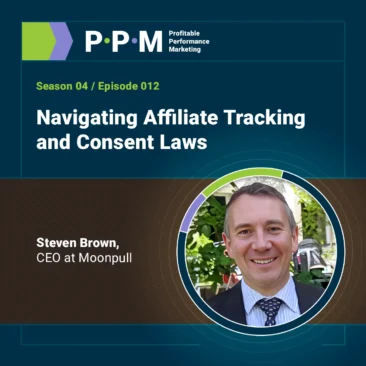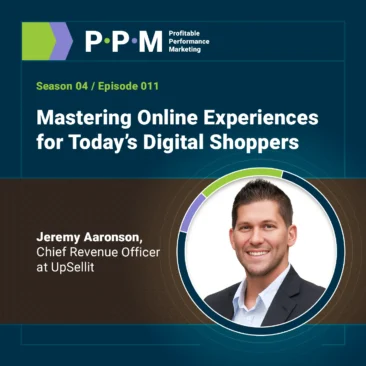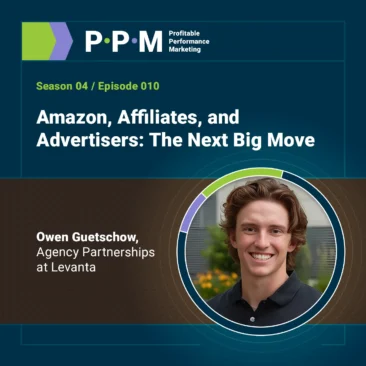Season 02 / Episode 018
Affiliate Marketing Paid Placements
Note: if you get only a 30 second preview, please log into your Spotify account, or find us on one of several other podcast services.
Summary
Should I be paying for placements on affiliate sites? Do I even know what that is? Today I talk about the concept of purchasing real estate on affiliate publishers’ sites and how it all works. From finding them, to pitfalls to avoid, to setting each one up for success and even what to do when they don’t work. We talk about it all on today’s episode.
Listen
Share
Notify
Transcript
[00:00:50] JB: Hey, everybody. This is Jamie Birch, your host of the Profitable Performance Marketing Podcast and CEO and Founder of the award winning affiliate management agency, JEBCommerce. Now, we are brushing up against our 18th year in business. So I’ve been doing this a long time. So here’s another solo episode, just me today talking about paid placements and how those fit in the affiliate world.
Now, you may be thinking, “Jamie, why would I need to do a paid placement? Affiliate marketing is commission-based.” Well, affiliate marketing comes down to a model for paying someone to do a thing, right? To sell your product. There are other agencies who believe that we shouldn’t be doing paid placements at all in affiliate marketing, and I don’t. I think, and we’ve always done this at JEB, is that we should be doing every single thing we can to achieve our customers’ goals.
I know when I worked at Coldwater Creek, if an opportunity came to me or an idea came to me, I pursued it wholeheartedly. We’ve done some pretty crazy things there and over time, but let’s talk about paid placements. So recently, I gave a training to some of our new staff on what those things are, and we talked about why they’re necessary. Some of the history, that success that we’ve had, how to identify those paid placements, how to even talk to our clients about those, how to evaluate them, and things like that.
So we’re going to go over a few of those today, but first talk about what is a paid placement. It’s pretty basic. It’s an advertisement position that we acquire or you could acquire for our clients or your affiliate program on a publisher site that you pay for upfront. Typically, you sign an insertion order and are guaranteed by the affiliate that you’ll receive that placement. You pay upfront for the placement. Oftentimes, you can pay via commission increase. You can pay with cash. You can offer a lot of different compensation. But typically, it is a unique, one-time payment of maybe $100, all the way up to $20,000.
I have done paid placements that have gone from 75 bucks, 100 bucks, all the way up to $75,000. So they can be much greater, but it is guaranteed real estate. So right now, if you are doing commission on this stuff, you’re included on their site, and you are included in those areas. But from time to time, how often you show up is going to be driven by how much they think you can earn. See, each affiliate, they know. They know with the data how much they earn with every single spot on their website. There used to be a time where they didn’t, but they are getting really sophisticated right now. So they know how much they earn at every single spot on their website and their email.
What happens is they know the value of that. So they can find a partner who will get that value or more through a commission, or they can offer anybody that maybe fit their criteria a way to buy in to get that spot, and that’s a paid placement. So paid placements really can include a lot of different things. It can be an inclusion in an affiliate’s consumer-facing email. I’ve even done solo emails sent by affiliates to their entire list, but some of the most successful ones have been solo emails to a segment of their list.
Most affiliates really are database-driven now, so they keep a ton of information about each of their customers. I used to do this quite a bit with apparel companies. They can tailor that email to go out to different segments like women 18 to 35 that are in dual-income homes and purchase apparel five times a year. So they can segment that out. A paid placement may be a solo email, and there are different emails that affiliates send, obviously, right? They send a newsletter that includes a whole bunch of different merchants. Maybe they send one out. That’s all their new merchants.
But then they’ll send stuff out that’s an apparel email. But they also segment their emails to people who frequently buy sneakers or people who buy electronics. So they may have a ton of different emails going out to different segments, and then you can also – So you may be included with 10 other advertisers in those emails. But, see, a solo email is just an email about you, and it gets sent out.
Now, at companies I’ve worked at, we’ve done this before and resulted in calls from our IT department over the weekend of, “Several of our server farms are down. What the hell are you doing?” It performs so well, and it was segmented to the exact segment that was buying our product, and that’s what they did. They bought our product. They flooded the website. So this can be done.
Paid placements can also include category mastheads on the category page that’s appropriate, premium sponsorship for those category pages, special inclusion and holiday sections, premier sponsorships. It could be a paid search budget increase. So think about that. Do you work with a paid search affiliate? Do you want to essentially buy more real estate in the search engines? It can be a sequence of all these things. It can be content creation or even a vlog creation. I’ve done all of those kinds of things.
So why do you want to do paid placements? Well, it guarantees exposure in a very specific way for your brand on the affiliate side. It adds ways that you can expose your brand to your audience and more of your audience. Some affiliates only work that way. If you want that ideal spot, this is the only way to get it. It gives you the ability to acquire real estate that performs for your brand and for your program, and it’s a great strategy to increase things rapidly. So if you want to grow quickly, this is a great way to do that. Like I said, affiliates know what each piece of real estate they own, how much that earns per 100 clicks, and they utilize that data. So it’s a reason they know what that earns. If you can’t always hit that with a commission, you can hit it in another way.
[BREAK]
[00:07:50] JB: Are you enjoying the show so far? One of the things we discuss often on the Profitable Performance Marketing Podcast is the importance of driving incremental sales in your affiliate program. But this topic can be very difficult to get your hands around by yourself. How do you know what an incremental sale is, and how do you know whether your affiliate program is set up to drive incremental sales?
Well, we set up a tool that allows you to benchmark your affiliate program against the best programs in the industry and the strategies that lead to incremental sales. You can access and use this free tool at jebcommerce.com/incremental. This tool covers seven different aspects of your affiliate program such as technology, your publishers, your promotion strategy, the internal resources available to you, your commission structure, available data, profitability measurements, and more. They’re all covered in this free tool.
I want you to be able to access this tool and find out exactly how your program stacks up all for free simply for being a listener of this podcast. Once you fill out this tool, you’ll get an email outlining where you stand, including recommendations in all those areas for what you need to do to drive more incremental sales. You can access this tool at jebcommerce.com/incremental. Now, back to our show.
[EPISODE RESUMED]
[00:09:21] JB: You should always be looking for additional ways to expose your brand and its products to your ideal audience, whether it’s commissioned-based or paid placement. So you want to make sure you’re going out and scouring that. Sometimes, a commission only you’re only going to get so far. So how do you identify paid placement opportunities?
Well, the first thing you want to do is you want to make sure you have a good network of other affiliate managers, other affiliate marketers that you can reach out to. What I suggest is you identify your top partners, and you reach out to them and ask for media kits. If you’ve never done this before, that’s the lingo you need, the media kit. You ask them, “Do you have a media kit on paid placement opportunities?” Send that out individually to your top partners. You’re going to get stuff in return. Identify the ideal potential partners. Contact them with that request. You may even want to go through the ones that you really have wanted to do business with, but it just hasn’t worked. Give this a shot. Then, again, build your network. Go to events like Affiliate Summit, CJU, DealMaker, and all the other events that you’re able to build your network of affiliates and affiliate managers. They will help you find those paid placement opportunities.
Let’s go over a few keys of setting up your paid placement for success, and these are things you’re going to do prior to your paid placement to make sure you can help evaluate it. So, one, you want to have an appealing offer. You want to have custom banners and text links for that placement. You want to determine the reporting prior to launch, so you know what you’re getting from the affiliate. So what kind of data are they going to send you? Determine your success metrics and KPIs prior to the placement going live, frankly, prior to you signing it. That’s especially helpful internally. If you’re asking for a budget that they’re not really comfortable with, ask them what would be the KPIs, what would be success to that.
You want to create custom links for each of those placements, so you can better track performance based on those links. This is something people forget sometimes. You want to set reminders in your calendar the day before to check assets. Make sure the affiliate has everything they need. The day of you want to check that it went live several times during when that placement is running. You want to make sure it’s there and a reminder afterwards to compile the data. I would place a test order. I can’t tell you how many times we’ve spent money for things, and the tracking wasn’t set up correctly. So place a test order and maybe you have a way on the back end of your analytics system to tag things. You can tag them on the back side, so you can make sure and see the data of how it performs.
When you’re evaluating your paid placement, you want to collect all that data, the link performance. The way that we really do it is you want to have some numbers. So you want to look at the data for the time period, collect the data for the time period when you ran the paid placement. So have that. But you want to compare it against the period before and the period after. So if you had a seven-day placement, look at the seven days that you ran beforehand and the seven days after and how it worked. You want to look at the same days or month, the same period the year before.
Then one of the great ways to do this is to look for a white period, and a white period is typically when you have no other things going on. So it’s just a blank canvas. This is the average when you’re not doing anything special of how the program performs, and you compare it to that. You can also look at the daily running average. Then you can look at link performance. So that will tell you how it did.
Now, will you ever be able to say 100% this is what it did over what it would have done without the placement? Not really. But you can get really, really close, and all that data will help you paint a really clear picture. But not every paid placement is a success. That same example I gave you earlier, when we brought down two out of three server farms, I did that same placement 30 days later. I spent $25,000, and we got about $4,000 in sales. So it’s not always going to work. It’s probably one of the things you need to remember is if you’re just getting into paid placements, these are all tests. I would say you need a year of placement testing. So you’re testing different affiliates, different seasons, different offers and different creative. It’s all a test.
After a year of testing, you’re going to get a lot of information. So next year, you can do even better. But still, you’re going to have things that fail. You want to make sure you have the data collected in all those different ways that I outlined earlier. You want to look through Google Analytics or whatever your back end analytics [might be]. Look at the coupon redemptions because sometimes the coupons are redeemed, and there may have been a tracking problem. Then you want to see if traffic increased or conversion rate or AOV, if there was a failure somewhere around there.
Then what we often do is we ask the affiliates for a “make good.” If we both, our affiliate partner and us, felt this was going to be really great, it was a good fit, but it didn’t work. We will ask them, “Okay. We know you’re not going to refund our money,” and typically they don’t. There’s no guarantees in what we do. I talked to someone today that said, “Affiliate marketing is like a sailboat. You do everything you can to get ready to catch the wind, and then you wait for the wind.” It’s a really good analogy of affiliate marketing. But sometimes, I will go through and I will ask them to be included somewhere else, and oftentimes that happens. The more pleasant you are with them and the longer history you have, the more likely you are to get that.
Anyway, these are paid placements. They’re nothing new that we’ve been doing this kind of thing forever. But people often don’t know that this is something they’re able to do and have access to some really great audiences and can increase their performance greatly. So, hey, hit me up with questions. What questions do you have about paid placements? Email me at gethelp@jebcommerce.com, and I will answer every single one of those. I may turn that question into a podcast episode.
If you felt this episode was especially informative, please share it on all your socials, Facebook, Twitter, LinkedIn. Share it with your friends, anyone you know that needs to hear this. We are constantly looking for new guests. So if you would like to be a guest on the Profitable Performance Marketing Podcast, please email me, again, at gethelp@jebcommerce.com. Even if you know someone who you would like to have on the podcast and have me interview, we would love to do that. If there are any episodes, any topics that you want me to address and talk about, you can email me at gethelp@jebcommerce.com. Don’t forget to share this. I hope you found this informative, and it was helpful. But thank you for listening.
[END]
Transcript Toggle





